Spanish Seafood Stew | Suquet de Mariscos
A delicious and warming seafood stew that enhances flavor with a traditional Catalan Picada.
There’s nothing quite like a Spanish Seafood Stew (Suquet de Mariscos) to bring the vibrant flavors of the Mediterranean to your table. This traditional Catalan dish combines tender white fish, plump shrimp, and fresh mussels simmered in a rich saffron-tinted broth with paprika, tomato, and a nutty almond picada.
The result is a rustic yet elegant seafood stew that’s deeply flavorful, comforting, and perfect for sharing. Serve it with crusty bread to soak up every last drop of the delicious sauce and enjoy a true taste of coastal Spanish cuisine.
This post may contain affiliate links.
Serving:
Main for 4-6
Ready in:
45 minutes
Skill level:
Easy
Serve with:
Fresh bread

Ingredients
For the seafood stew
- 14 oz. (400g) white fish fillets (fresh or frozen)
- 7oz. (200g) shrimp, peeled and deveined
- 14 oz. (400g) of Fresh Mussels (cleaned and beards removed)
- Extra Virgin Olive Oil
- 1 onion, diced fine
- 2 tomatoes, grated
- 3 potatoes, cut into cubes
- 1 tsp sweet Spanish paprika
- 1 Bay leaf
- 1 cup white wine
- 4 cups of Fish broth (low sodium, or homemade)
For the Picada
Equipment
- Mortar and Pestle
- Large pot or skillet (we use Circulon cookware)
- Large pot with lid
- Wooden cutting board
- Chef knife
- Box Grater
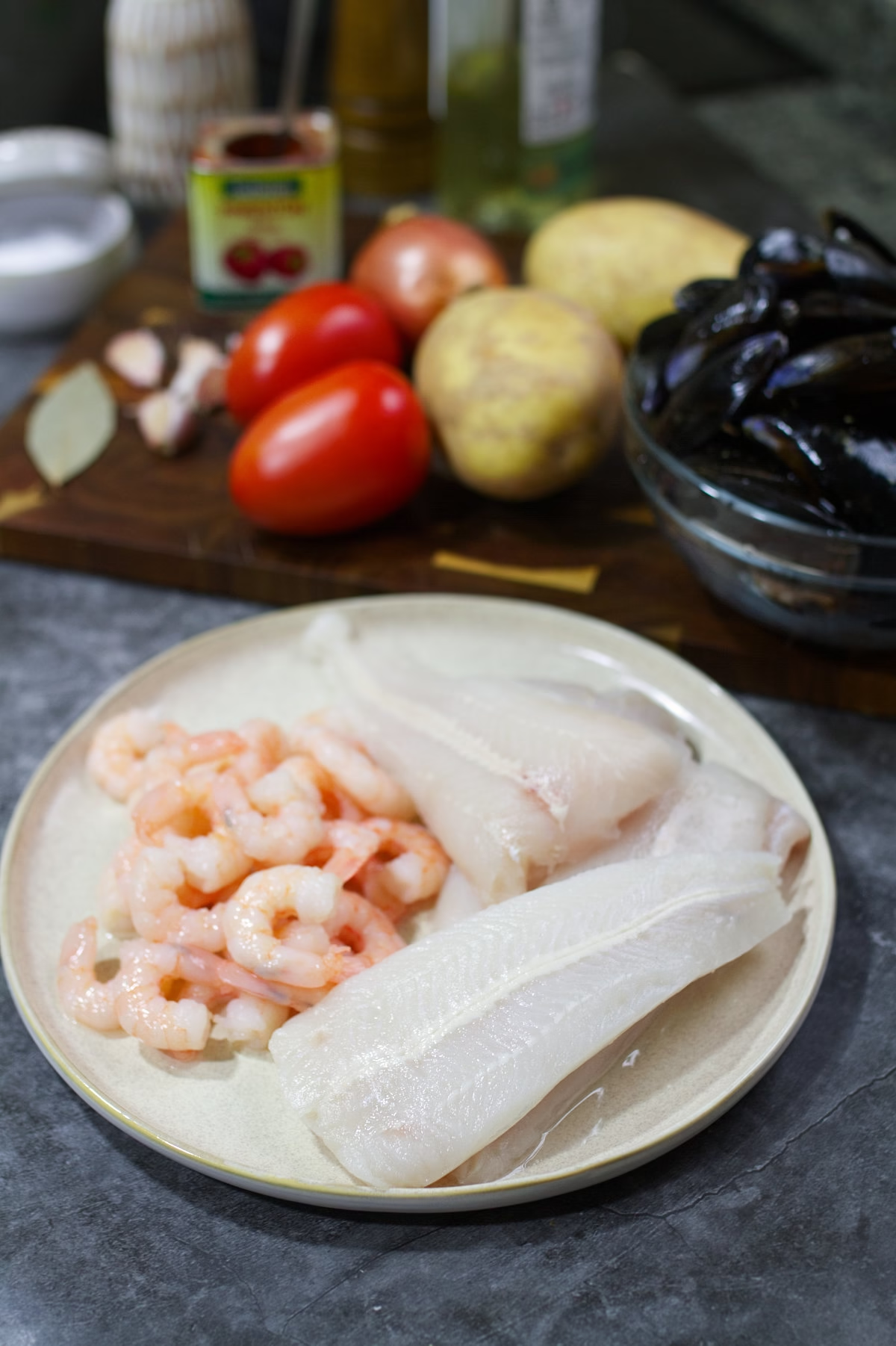
Instructions
Step 1 – Prepare the Fish Broth
NOTE: Skip this step if using store-bought fish broth
- Remove the shrimp shells and fish head and add to a large pot with around 4-5 cups of water, 1 tbsp salt, cracked black pepper, and a handful of fresh parsley.
- Add the veg ends, peelings etc as you go when prepping the veg.
- Bring to a boil and then reduce heat and simmer for 20-30 minutes while you make the rest of the recipe.
Step 2 – Prepare the Picada
- Add the peeled garlic cloves, almonds, stale breadcrumbs, and chopped parsley to a pestle and mortar and grind into a paste. This should take around 5 minutes.
- Add a splash of oil if the mixture is too dry.
- Season to taste with salt and pepper.
- Set aside or use later.
Step 3 – Prepare the Stew Base
- Add a splash of oil to large pot or pan and bring to a medium high heat.
- Add the large shrimp and fry for 2-3 minutes per side, just enough time for them to get some color. Remove the shrimp from the pan and set aside for use later.
- Add the onion and cook until translucent, around 5 minutes.
- Add the grated tomato, the picada, and 1 cup of fish broth and stir through.
- Reduce heat to medium, add the paprika and season to taste, then add a few more cups of fish broth and the potatoes and cook for around 10-12 minutes until the potatoes become tender.
Step 4 – Add the Fish and Seafood
- Add the cleaned mussels and the chunks of fish and stir through.
- Check liquid levels and add more fish broth if required. You should have enough broth to cover everything.
- Cook the fish and mussels on a medium heat for 8-10 minutes, then add the cooked shrimp and check seasoning.
- Cook for another 5-10 minutes or until the mussels open and the fish become opaque.
Step 5 – Serve
- Garnish with a little freshly chopped parsley, and serve in deep-sided bowls with some fresh bread.
Cooking tips:
- Ask your fishmonger for cleaned and de-bearded mussels to save some time.
- Fresh or frozen fish both work well. If using frozen fish, be sure to thaw it first.
- Don’t over cook the fish. White fish that’s around ½ inch thick will only take around 10 minutes to cook. Cook it any longer and it will flake apart (see cooking video).
- Use Sweet Spanish paprika instead of smoked paprika, it will enhance the flavors in the seafood.
- Keep the veg minimal to allow the seafood flavors to stand out. 1 onion, a few tomatoes, and a few potatoes is plenty. Remember, less is more.

Origin of this Recipe
Suquet de Mariscos is a traditional Catalan seafood stew that hails from Spain’s northeastern Mediterranean coast, particularly from the fishing villages of Catalonia and Valencia. The name “suquet” comes from the Catalan word “suc,” meaning juice or broth — a nod to the dish’s soul: its rich, flavorful sauce.
Originally, this humble fisherman’s stew was made with the day’s catch, simmered slowly with potatoes, tomatoes, garlic, and saffron to create a hearty, comforting meal after a long day at sea. Over time, Suquet de Mariscos became a beloved dish throughout Spain, celebrated for its rustic simplicity and deep connection to coastal life.
Picada
A picada is one of the secrets behind the rich flavor of many Catalan stews and sauces. It’s a traditional paste made by grinding together toasted almonds (or hazelnuts), garlic, stale bread, and fresh parsley using a mortar and pestle.
In Suquet de Mariscos, the picada is stirred into the stew near the end of cooking, where it thickens the broth and adds a subtle nutty depth that perfectly complements the sweetness of the seafood. Think of it as the Catalan equivalent of a French roux or Italian sofrito — a small addition that makes a big difference in flavor.

Regional Variations of Suquet de Mariscos
Like many traditional Spanish dishes, Suquet de Mariscos changes subtly from one coastal region to another — each area putting its own twist on this beloved seafood stew.
Catalonia/Cataluña
(Costa Brava):
The classic version comes from Catalonia’s rugged coastline, where fishermen would cook their catch right on the beach. It’s typically made with monkfish, mussels, and shrimp, and always includes a homemade picada to thicken and flavor the broth.
Discover more recipes with our Catalonia Regional Foodie Guide
Valencia:
Further south, Valencian cooks often add saffron for color and aroma, and sometimes a touch of white wine or brandy to enrich the sauce. Potatoes are almost always included, making the stew more filling.
More recipes from Valencia in our complete Valencia Regional Foodie Guide
Balearic Islands (Mallorca & Menorca):
Island versions tend to be lighter, often featuring local rockfish, squid, and a splash of Mediterranean olive oil. Some cooks even add a spoonful of sofrito (a slow-cooked tomato and onion base) before the picada for extra depth.
Come explore with us with our Balearic Islands Regional Foodie Guide.
Modern Variations:
Today, chefs across Spain and beyond are reimagining Suquet de Mariscos with creative touches — from adding clams, scallops, or langoustines, to swapping potatoes for fennel or chickpeas. Yet the heart of the dish remains the same: fresh seafood, simple ingredients, and a soulful Mediterranean broth.
Romesco de Peix
Catalan Fish Stew | 30-Min recipe
Oven Baked Fish Casserole
with homemade romesco sauce
Spanish Fish & Seafood Pie
Ready in 1 hour
What Fish and Seafood to Use in Suquet de Mariscos
A great Spanish seafood stew is all about using a mix of fresh, sustainable seafood that adds layers of texture and flavor. Traditionally, Suquet de Mariscos was made using whatever the local fishermen caught that day — so feel free to mix and match based on availability.
Best Fish to Use:
- White fish fillets like hake (merluza), monkfish (rape), cod (bacalao), or sea bass (lubina) are ideal.
- These firm, mild fish hold together well in the stew and absorb the rich broth beautifully.
- Avoid oily fish like mackerel or sardines, as they can overpower the delicate flavor.
Recommended Seafood:
- Shrimp or prawns – Add sweetness and texture; keep a few whole for presentation.
- Mussels or clams – Bring a briny depth and release natural juices into the broth.
- Squid or cuttlefish – Traditional in many coastal versions; adds a tender, slightly chewy bite.
- Scallops (optional) – For a luxurious touch and subtle sweetness.
Tip:
If you’re using frozen seafood, make sure it’s fully thawed and patted dry before cooking to prevent excess liquid from diluting the stew.

Seafood Substitutions & Budget-Friendly Options
Don’t worry if you can’t find every type of seafood for your Spanish seafood stew — Suquet de Mariscos is meant to be flexible! The beauty of this dish is that it adapts easily to what’s fresh, local, or affordable.
Affordable Substitutes:
- Frozen white fish fillets (such as pollock or tilapia) work surprisingly well and keep their texture in the stew.
- Frozen seafood mixes (often including shrimp, mussels, and squid) are a great time-saver — just thaw and drain before adding.
- Canned clams or mussels can be used in a pinch to add that briny flavor if fresh shellfish aren’t available.
Premium Add-Ins (for special occasions):
- Lobster or langoustines – for a rich, restaurant-style version.
- Sea bream (dorada) or turbot (rodaballo) – firm and flavorful white fish ideal for impressing guests.
Pro Tip:
No matter which seafood you use, aim for a balance of textures — a mix of firm white fish, tender shellfish, and something meaty like shrimp or squid makes the stew satisfying and well-rounded.

Wine Pairing for Spanish Seafood Stew (Suquet de Mariscos)
A flavorful Spanish seafood stew deserves a wine that complements its delicate balance of briny seafood, rich broth, and warm Mediterranean spices. The key is to choose wines with bright acidity and subtle minerality to lift the flavors without overpowering them.
Best White Wine Pairings:
- Albariño (Rías Baixas) – A classic Spanish pairing. Its crisp citrus notes and saline finish mirror the freshness of the sea.
- Verdejo (Rueda) – Zesty and aromatic, with hints of green apple and herbs — perfect with fish and shellfish.
- Godello (Valdeorras) – Fuller-bodied but still fresh, ideal for a richer stew base with almonds and paprika.
Rosé Options:
- Navarra Rosado or Catalan rosé wines – Light, fruity, and slightly dry, they match beautifully with tomato-based broths and shrimp.
If You Prefer Red:
- Choose a light, fruity red like Mencía (Bierzo) or a young Rioja (Crianza). Serve it slightly chilled — the gentle tannins won’t clash with the seafood.
Sommelier Tip:
If your stew leans heavier on shellfish, stick with whites and rosés. If it’s more robust with monkfish or a richer broth, a young, fresh red can surprise you in the best way.
Serving Suggestions for Suquet de Mariscos
A hearty Spanish seafood stew like Suquet de Mariscos is best enjoyed family-style — steaming hot, served straight from the pot, and shared with good bread and wine.
Classic Accompaniments:
- Crusty bread or rustic baguette – Essential for soaking up every drop of the flavorful broth.
- Alioli (garlic mayo) – A traditional Catalan condiment that adds a creamy, garlicky contrast. Serve a small dollop on the side or swirl it into the broth for extra richness.
- Healthy Spanish Green Salad or grilled vegetables – A light, refreshing side that balances the stew’s deep flavors.
- Patatas bravas or roasted potatoes – For a heartier meal, serve alongside small Spanish tapas.
- Spanish Potatoes | Patatas a la Importancia
- Poor Man’s Potatoes – Patatas a lo Pobre
Serving Style Tip:
Ladle the stew into deep bowls, ensuring each portion gets a mix of fish, shellfish, and broth. Finish with a drizzle of extra virgin olive oil and a sprinkle of fresh parsley for color and aroma.
Storage & Reheating Tips
Like many stews, Suquet de Mariscos tastes even better the next day — but seafood needs a gentle touch to stay tender and flavorful. Here’s how to store and reheat it properly.
Storing:
- Allow the stew to cool completely before transferring it to an airtight container.
- Store in the refrigerator for up to 2 days.
- If you’ve used shellfish (like mussels or clams), remove them from their shells before storing to prevent an overly “fishy” flavor.
- For longer storage, freeze only the broth and vegetables (up to 3 months). Add fresh seafood when reheating for best texture.
Reheating:
- Reheat gently over low heat on the stovetop until just warmed through. Avoid boiling — it can make the fish rubbery.
- If microwaving, use short 30-second bursts and stir between each to distribute heat evenly.
- Add a splash of fish broth or water if the stew thickens in the fridge.
Pro Tip:
Before serving, refresh the flavors with a drizzle of olive oil, a squeeze of lemon, or a sprinkle of chopped parsley.
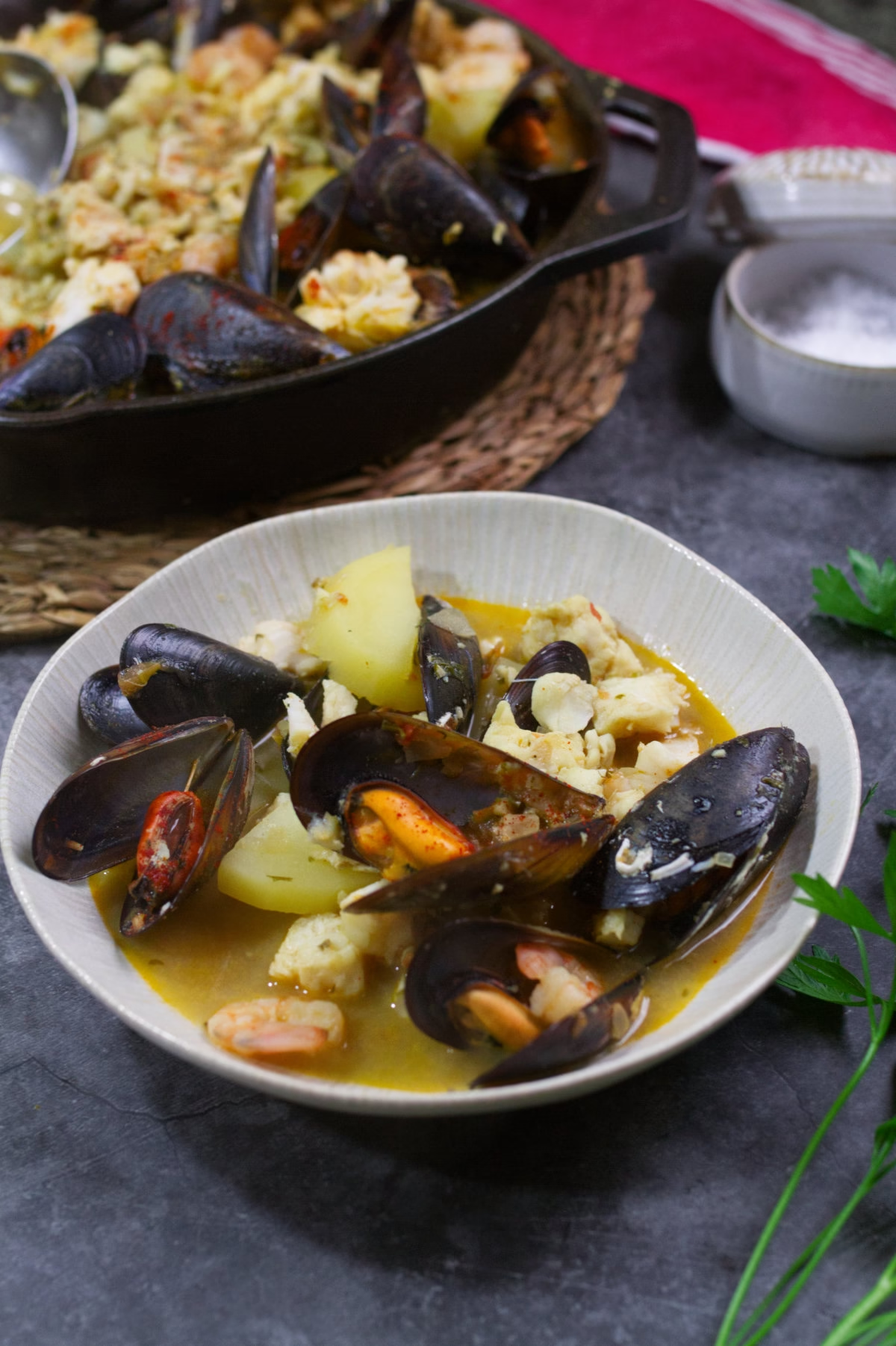
More Seafood Recipes:
- Brothy Fish Stew with Shrimp, Rice, and Pesto Paste (Arroz Caldoso de Pescado)
- One-Pot Mediterranean Fish Stew (Zarzuela de Mariscos)
- Maravilla fish stew with chickpeas and pearl pasta
- Seafood Soup – Sopa de Mariscos
- Oven Baked Fish Casserole With Romesco Sauce
Nutrition Facts
(per serving)
| Nutrient | Amount per Serving | % Daily Value (DV) |
| Calories | 385 kcal | 19% |
| Total Fat | 17 g | 22% |
| Saturated Fat | 2.5 g | 13% |
| Trans Fat | 0 g | — |
| Cholesterol | 145 mg | 48% |
| Sodium | 720 mg | 31% |
| Total Carbohydrates | 20 g | 7% |
| Dietary Fiber | 3 g | 11% |
| Total Sugars | 4 g | — |
| Added Sugars | 0 g | 0% |
| Protein | 38 g | 76% |
| Vitamin D | 5.5 µg | 28% |
| Calcium | 90 mg | 7% |
| Iron | 3.2 mg | 18% |
| Potassium | 980 mg | 21% |
| Vitamin C | 20 mg | 22% |
⚖️ Notes:
- Nutritional values are approximate and may vary depending on the specific seafood and ingredients used.
- Based on a recipe made with white fish (hake or cod), shrimp, mussels, potatoes, olive oil, tomatoes, and almonds.
- This stew is high in lean protein, rich in potassium, and a good source of healthy fats from olive oil and almonds.
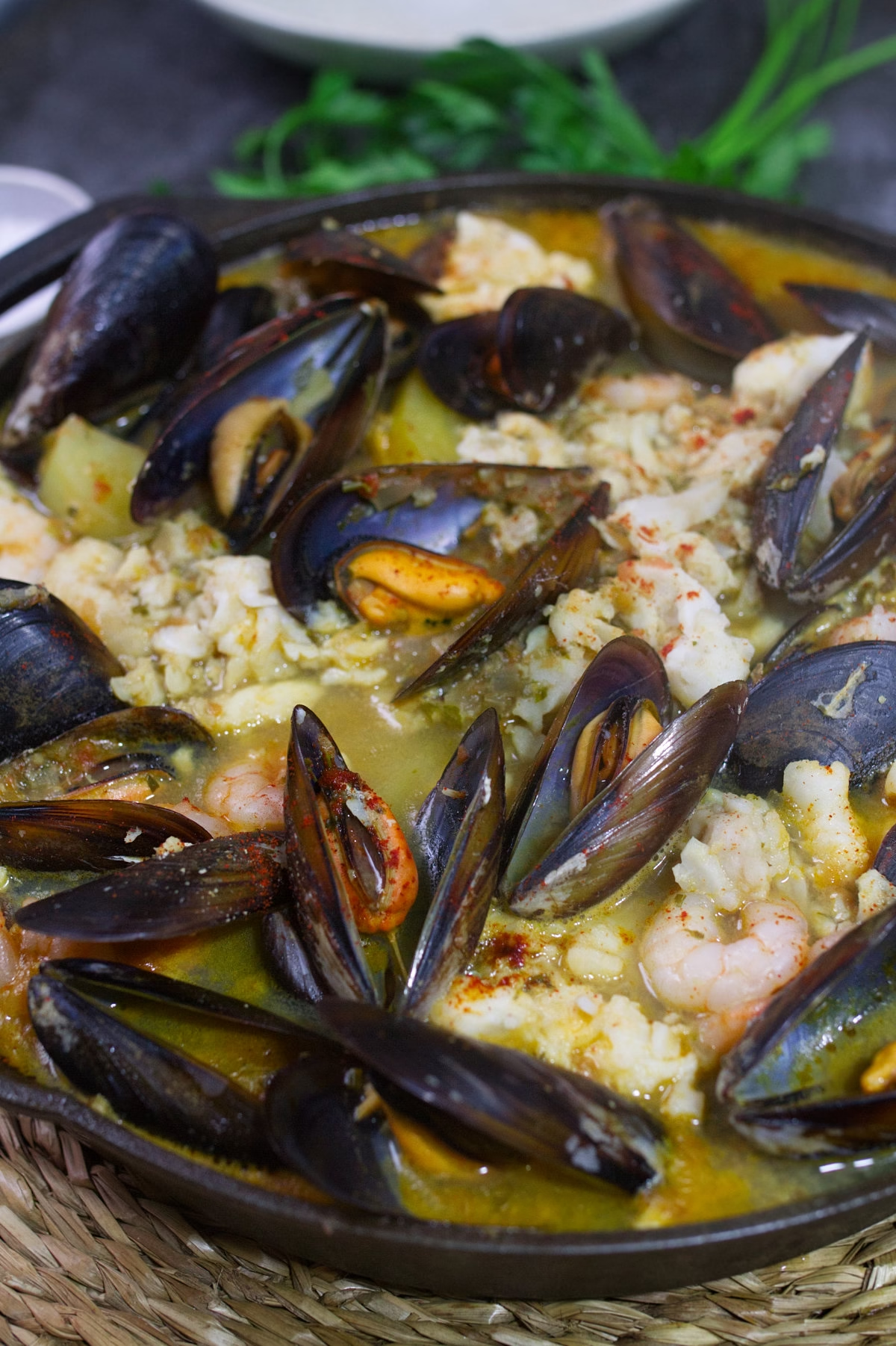
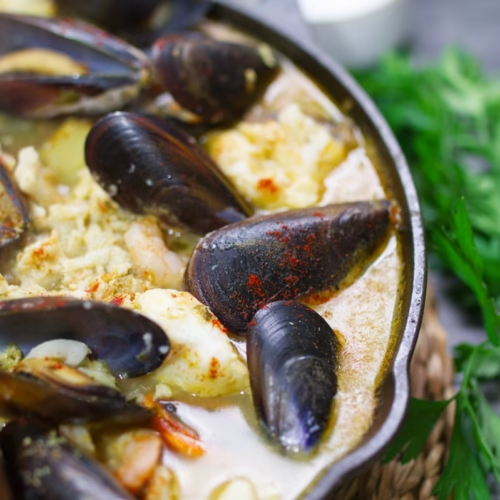
Spanish Seafood Stew | Suquet de Mariscos
Equipment
- Mortar and pestle
- Large pot or skillet (we use Circulon cookware)
- Large pot with lid
- Wooden cutting board
- Chef knife
- Box grater
Ingredients
For the seafood stew
- 14 oz. 400g white fish fillets (fresh or frozen)
- 7 oz. 200g shrimp, peeled and deveined
- 14 oz. 400g of Fresh Mussels (cleaned and beards removed)
- Extra Virgin Olive Oil
- 1 onion diced fine
- 2 tomatoes grated
- 3 potatoes cut into cubes
- 1 tsp sweet Spanish paprika
- 1 Bay leaf
- 1 cup white wine
- 4 cups of Fish broth low sodium, or homemade
For the Picada
- 3 Garlic cloves
- 50 g almonds
- Salt & black pepper to taste
- A handful of fresh chopped parsley
Instructions
Step 1 - Prepare the Fish Broth
- NOTE: Skip this step if using store-bought fish broth
- Remove the shrimp shells and fish head and add to a large pot with around 4-5 cups of water, 1 tbsp salt, cracked black pepper, and a handful of fresh parsley.4 cups of Fish broth
- Add the veg ends, peelings etc as you go when prepping the veg.
- Bring to a boil and then reduce heat and simmer for 20-30 minutes while you make the rest of the recipe.
Step 2 - Prepare the Picada
- Add the peeled garlic cloves, almonds, stale breadcrumbs, and chopped parsley to a pestle and mortar and grind into a paste. This should take around 5 minutes.3 Garlic cloves, 50 g almonds, Salt & black pepper, A handful of fresh chopped parsley
- Add a splash of oil if the mixture is too dry.Extra Virgin Olive Oil
- Season to taste with salt and pepper.
- Set aside or use later.
Step 3 - Prepare the Stew Base
- Add a splash of oil to large pot or pan and bring to a medium high heat.
- Add the large shrimp and fry for 2-3 minutes per side, just enough time for them to get some color. Remove the shrimp from the pan and set aside for use later.7 oz. 200g shrimp, peeled and deveined
- Add the onion and cook until translucent, around 5 minutes.1 onion
- Add the grated tomato, the picada, and 1 cup of fish broth and stir through.2 tomatoes
- Reduce heat to medium, add the paprika and season to taste, then add a few more cups of fish broth and the potatoes and cook for around 10-12 minutes until the potatoes become tender.3 potatoes, 1 tsp sweet Spanish paprika, 1 Bay leaf, 1 cup white wine
Step 4 - Add the Fish and Seafood
- Add the cleaned mussels and the chunks of fish and stir through.14 oz. 400g of Fresh Mussels (cleaned and beards removed)
- Check liquid levels and add more fish broth if required. You should have enough broth to cover everything.
- Cook the fish and mussels on a medium heat for 8-10 minutes, then add the cooked shrimp and check seasoning.14 oz. 400g white fish fillets (fresh or frozen)
- Cook for another 5-10 minutes or until the mussels open and the fish become opaque.
Step 5 - Serve
- Garnish with a little freshly chopped parsley, and serve in deep-sided bowls with some fresh bread.
Video
Notes
Cooking tips:
- Ask your fishmonger for cleaned and de-bearded mussels to save some time.
- Fresh or frozen fish both work well. If using frozen fish, be sure to thaw it first.
- Don’t over cook the fish. White fish that’s around ½ inch thick will only take around 10 minutes to cook. Cook it any longer and it will flake apart (see cooking video).
- Use Sweet Spanish paprika instead of smoked paprika, it will enhance the flavors in the seafood.
- Keep the veg minimal to allow the seafood flavors to stand out. 1 onion, a few tomatoes, and a few potatoes is plenty. Remember, less is more.
FAQs – Suquet de Mariscos (Spanish Seafood Stew)
- What is Suquet de Mariscos?
Suquet de Mariscos is a traditional Catalan seafood stew made with a mix of fish, shellfish, potatoes, and a nutty almond-garlic paste called picada. It’s a comforting dish that celebrates the flavors of the Mediterranean coast. - What is picada and why is it important?
Picada is a traditional Catalan paste made by grinding garlic, toasted almonds, stale bread, and parsley. It’s stirred into the stew at the end to thicken the broth and add rich, nutty depth to the flavor. - What kind of fish is best for Spanish seafood stew?
Firm white fish like hake, monkfish, cod, or sea bass work best. They hold their shape during cooking and absorb the delicious broth without falling apart. - Can I make Suquet de Mariscos ahead of time?
Yes — the broth and vegetables can be made a day in advance. Reheat gently and add the seafood just before serving to keep it tender and fresh. - Can I freeze Suquet de Mariscos?
It’s best to freeze only the broth (without seafood), as fish and shellfish can become rubbery once thawed. Add fresh seafood when reheating for the best texture. - What wine pairs well with Suquet de Mariscos?
Crisp Spanish whites like Albariño, Verdejo, or Godello pair beautifully. For something different, try a dry rosé or a light red like Mencía served slightly chilled. - What should I serve with Spanish seafood stew?
Serve with crusty bread, alioli (garlic mayo), and a simple green salad. These sides complement the rich, savory broth and complete the meal.
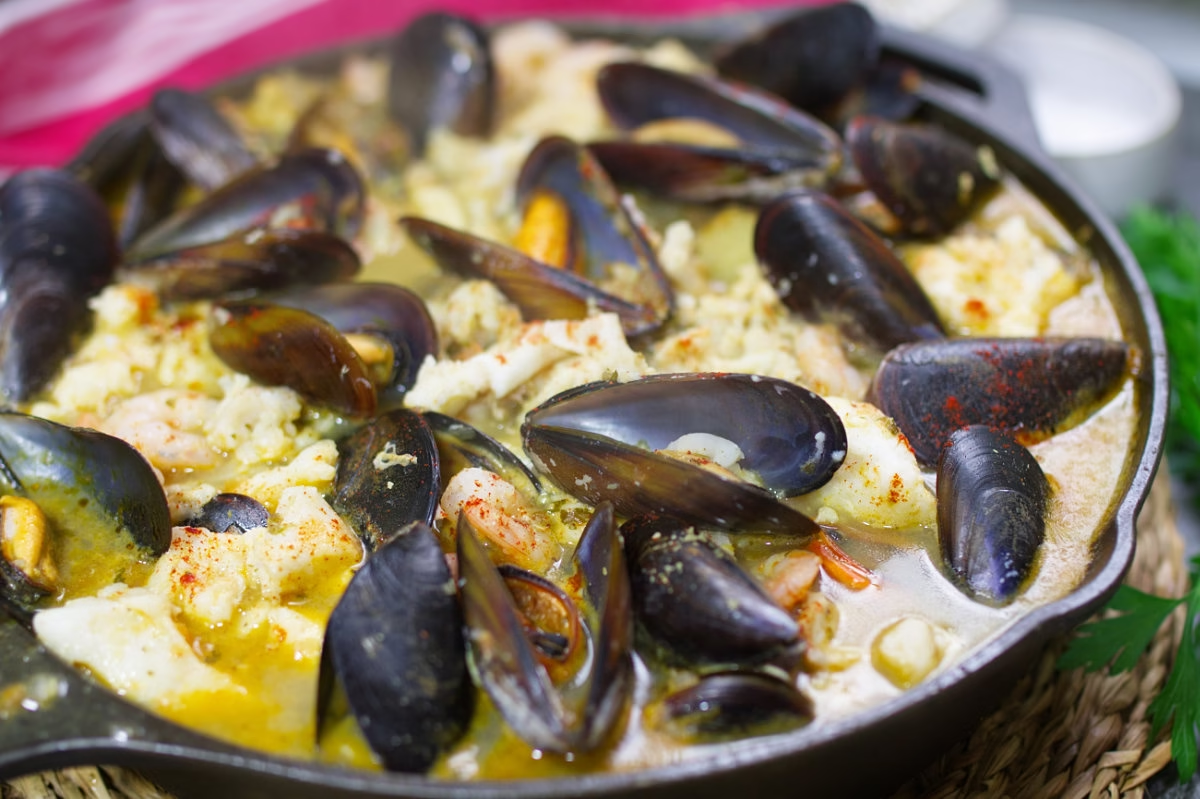
Love this recipe?
Leave us a comment and tell us your favorite Spanish recipe!

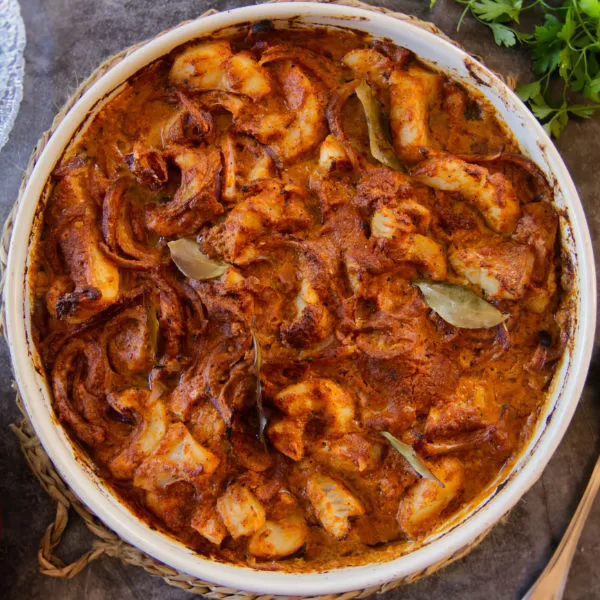
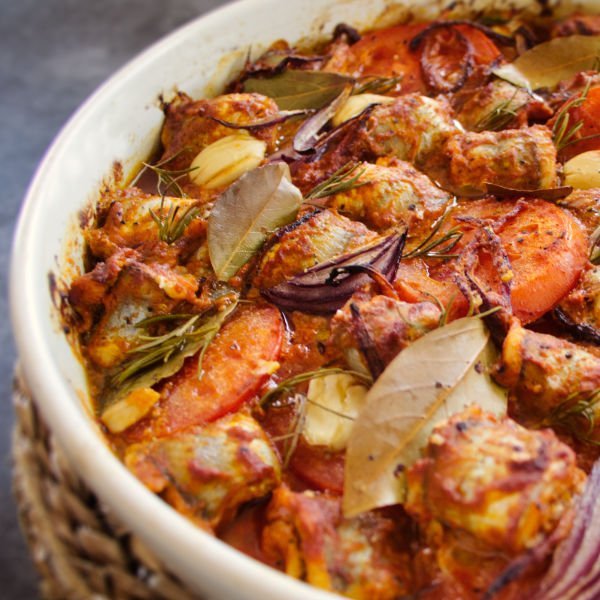


0 Comments